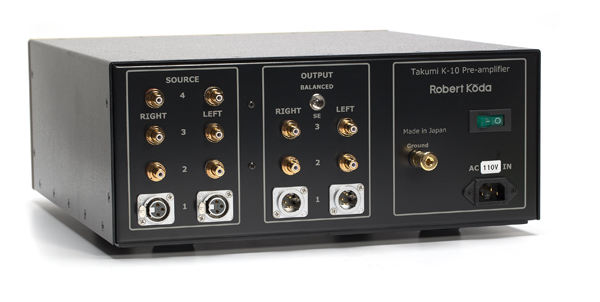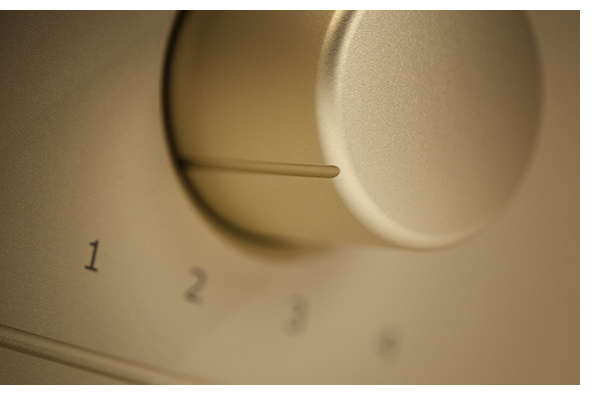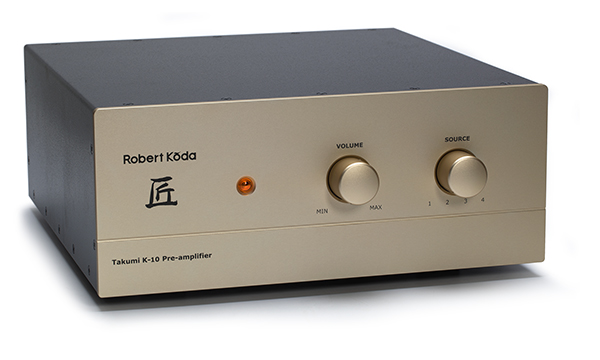 My favorite way to initially experience any audio component is to listen to a record I’ve heard hundreds of times, regardless of fidelity. A recording you intimately know serves you well when trying to get a read on the sound of something new.
My favorite way to initially experience any audio component is to listen to a record I’ve heard hundreds of times, regardless of fidelity. A recording you intimately know serves you well when trying to get a read on the sound of something new.
Until the K-10 arrived, my system hadn’t undergone any changes for nearly a year. When my chosen LP, an early mono copy of Big Brother and the Holding Company’s Cheap Thrills, hit the turntable, I wasn’t prepared for the amount of sensory input delivered to the auditory part of my brain. It’s similar to going from excellent digital to the most sublime analog experience. Or perhaps, moving from a standard violin to a Stradivarius.
In Japanese, the word “takumi” has a few translations. The one corresponding to the Kanji character imprinted on the preamp’s front panel means “artisan.” I can’t think of a component I’ve reviewed more worthy of the title. More than just richness, or an increase in tonal saturation, the K-10 provides an almost infinite upsurge in resolution. Think of it as such: When increasing the magnification of a photographic image on your computer screen, a point is reached wherein everything is reduced to pixels and falls apart because of the maximum capacity of the screen’s resolution. However, with the K-10, even after months of critical listening, there seems to be no limit as to how far you can peek into a recording.
Similar effects occur with a Japanese pressing of Bruce Springsteen’s The Wild, The Innocent, & The E-Street Shuffle. The horns and vocals breathe with life, with new surprises everywhere on a record to which I’ve been listening for nearly 40 years. Much like the Sonus faber Aidas reviewed this issue, the K-10 takes you somewhere you’ve never been—and that’s exciting.
Simple, Yet Simply Amazing
The cost of this experience? $31,000. Plus the price of a remote. The K-10 does not include one. A purist design, this solid-state preamplifier achieves greatness via extreme refinement, not so-called proprietary this or that. No part of the K-10 receives less than punctilious attention to detail. And although it’s solid-state, nearly everything is wired point to point, with only two tiny internal PCBs. Koda says the latter feature gold placed over thick copper tracks, and one enjoys point-to-point silver wiring.
The audio circuit and power supply are not only separated from each other, they are each built into their own sub-enclosures inside the chassis. The choke power supply is encased in a magnetic vault comprised of 2mm-thick soft iron; the preamplifier circuit is inside a mu-metal case, within a copper compartment and again the whole preamplifier is again encased in a copper chassis. To minimize switching noise, the model only uses two diodes and a zero-feedback discreet voltage regulator.
The attenuator uses exotic, precision carbon composition resistors specifically designed for audio use (Koda stresses that these parts are only used in audio applications). An L-Pad design means there are never more than two resistors in the circuit at any given time. This, compared to that of a ladder design with multiple resistors and solder joints.
Interestingly, the K-10 doesn’t respond to additional tweaks or attempts to further control vibration. It is built like a bank vault. Its robust power supply makes it one of the only components we’ve reviewed that does not really react to upgrades in the power path. (The other is the Naim CD-555.) Swapping power cords proves fruitless, and the K-10 doesn’t sound much different when plugged directly into the wall or a variety of expensive power line conditioners.
Such perfection is not easy to achieve. Every aspect of the K-10 is hand-assembled. Each unit takes about a week to assemble. At almost 60 pounds, it weighs as much as many of the power amplifiers we’ve reviewed. My ARC REF 5SE and Burmester 011 feel lightweight in comparison!
 Relax and Listen
Relax and Listen
Going without a remote control forces you to sit and listen, and realize the benefits of your favorite music. The K-10’s Zen-like tranquility sneaks up slowly, and after becoming fully acclimated to its presentation, I find myself programming sessions by album sides and whole albums—how I used to listen before becoming spoiled with remotes. I love it.
Initial listening—described at the beginning of this review—was conducted via my Linn LP-12 and a Shure V15vmxr. Yeah, the experience was that compelling. I wasn’t ready for how much more information the AVID Acutus Reference/Lyra Atlas/Indigo Qualia brought to the system. It’s like driving a high-powered 12-cylinder car for the first time. The staggering resolution is initially intoxicating and over-stimulating. Mark Mothersbaugh of Devo put it best in the inner sleeve of Duty Now For The Future: “Add a third dimension to your 2D world.”
Yet it’s even more. Everything played through the K-10 possesses extra dimension and resolution; it’s as if music now possesses a fourth dimension. Much as I love great digital reproduction, the K-10 reproduces things in a continuous tone manner, like rotogravure printing or high-speed open-reel tape. The flow of musical notes and space between them bring you even closer to the illusion of feeling you’ve brought performers into your listening room.
Aimee Mann’s voice gently floats between my speakers when listening to “Invisible Ink.” Major space between her vocal pauses and guitar accompany bass that rises up from the floor, folding into the mix. Miniscule environmental sounds on the title track to Lost In Space float like fireflies, buzzing past your head.
If You Need to Rock
Make no mistake, the K-10 has a rock-solid foundation and plays highly dynamic selections with equal ease. Jimi Hendrix’s classic Are You Experienced? comes through in a thunderous manner, his groundbreaking distortion effects more exciting because of the additional resolution. And Van Halen II never sounded better. Yes, distorted rock recordings can even achieve exalted status on a high-performance system.
The ultra-low noise floor always feels like it plays a few db louder, another bonus when playing acoustic music. Guitars, drums, and percussion explode in a way that hasn’t happened before in my system, regardless of amplifier model or type employed. Leading and trailing transients occur with immediacy, possessing no overhang on either end, and abolishing listener fatigue in the process. Music lovers that appreciate string quartets and small-ensemble music will be shocked by the realism.
Really? No Tubes?
Out of respect to Mr. Koda, I did not pop the inner covers to photograph the K-10’s insides. While a few audio buddies insist it’s a vacuum tube preamplifier, this component is in a category by itself. The combination of the K-10 and Burmester 911 mk. 3 or Pass XA200.5 monoblocks is eerily quiet. With the volume control up to the fullest degree, nothing emanates from the speakers, even with my ear solidly against the tweeter.
All this translates into an anchor that extracts the maximum amount of music from your sources and does so inclusively. The K-10 underscores the ideal that a truly fantastic music system sounds wonderful, regardless of the music in your collection. Granted, the most pristine pressings have offer more, but even the most mediocre records on my shelves sound enticing played through a system based around the K-10. There is so much information to discover, you will want to listen to all of your music again.
I have one complaint: a wish for finer gradation in the steps of the attenuator. Every amplifier I tried had a point at the upper range of the control that always felt as if it could use an intermediate step between settings. However, as I adjusted to not having a remote control, I quickly adopted to any gradation shortcomings, which were much easier to deal with on the digital side since the dCS Paganini allowed fine-tuning via its excellent digital volume control.
Ins and Outs
Thanks to more than 10v of maximum output and an extremely low output impedance, (75 ohm balanced, 37 ohm x 2 single-ended RCA), the K-10 works well with every power amplifier at my disposal and has no trouble driving 20-foot interconnects via single-ended or balanced outputs.
Three RCA inputs, and one XLR input are neatly arranged on the rear panel. Two sets of RCA and a true balanced XLR output is also available. I noticed no difference in sound quality between inputs or outputs. Mr. Koda notes that in order for the XLR output to be a true balanced output, this option must be selected with the rear panel switch.
A circuit breaker-protected power switch also resides on the back, and is not lit, again emphasizing the design’s utter simplicity. The owner’s manual suggests the preamplifier not be powered on for extended periods of time. Unlike many other solid-state preamplifiers I have used, it stabilizes from being cold in virtually no time.
 What an Experience
What an Experience
The individual parts, the resistors, capacitors, and switches comprising an amplifier, preamplifier, or other component all affect the final sound. And often, active components—primarily solid-state or vacuum tubes—feature a characteristic sound. Reviewers and consumers usually refer to transistors as having a more analytical sound, while tubes are generally characterized as having a warmer, more organic sound.
Rare, however, are components that have so little coloration and lack of a “sound.” The Robert Koda K-10 preamplifier is the finest example of this trait I’ve experienced. If you can’t bear to live without a remote control, the K-10 is not the best choice for you. If you are prepared to let go of convention and immerse yourself in pure sound, I suspect you will love the K-10 as much as I do.
To be sure I’m not dreaming, Mr. Koda has agreed to grant me a long-term loan on the K-10. I will produce a follow-up review at end of 2013, after the preamp has been used as a reference component with a wider variety of power amplifier and source combinations.
Robert Koda Takumi K-10
MSRP: $31,000
Peripherals
| Analog Source |
AVID Acutus Reference SP TriPlanar arm Lyra Atlas Cartridge AMG V12 AMG arm Clearaudio Goldfinger |
| Digital Source |
dCS Paganini stack Aurender S10 music server |
| Phonostage |
Audio Research REF Phono 2SE Pass XP-25 Indigo Qualia |
| Power Amplifier |
Burmester 911mk.3 Pass XA200.5 monoblocks Octave Jubilee monoblocks |
| Speakers |
GamuT S9 Sonus faber Aida |
 Living with a hifi component for a long period of time is either a wonderful or dreadful thing. Features that seemed annoying at first can really be problematic after a time and magic that wasn’t always apparent at first really shines after about a thousand albums.
Living with a hifi component for a long period of time is either a wonderful or dreadful thing. Features that seemed annoying at first can really be problematic after a time and magic that wasn’t always apparent at first really shines after about a thousand albums.






















